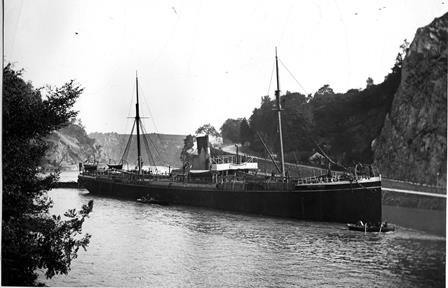From Start to Netley Abbey Ten years of research above and below the waterline
The wreck of a large iron steamship lies four miles south-south west of St Alban's Head on the Dorset coast; the wreck site being well known but not regularly visited. Those who have been there may know it by various names and popular dive guides refer to it as Start or Hartburn. It is unlikely that the wreck in this position is either of those vessels. Using information gathered from both the current day wreck site and referring back to original documentation numerous other possible candidates have been identified and eliminated. This leads to the conclusion that the identity for this shipwreck is Netley Abbey sunk by collision with HMS Surprise in 1899. |

Four miles SSW (202.5º) of St Alban's Head on the Dorset coast lays the wreck of a large iron steamship. About one mile to the east of the more recent and popular wreck of the Aeolian Sky this dive site is well known but not regularly visited. Those who have been there may know it by various names, the most likely being the Hartburn or the Start.
Probably the most popular reference book for divers along the Dorset coast is Dive Dorset, [1] which provides positions and descriptions for popular dive locations. Dive Dorset includes the position for this wreck, describing it as ‘a large wreck with at least two very large boilers’ and suggests it may be the wreck of the Hartburn. [2]
The description continues: |
"The position is 1 mile north-east of the Aeolian Sky (Site 200) and 1 mile west of what used to be thought the position of the Start. It is possible this is the wreck of the 2,367 gross ton merchantman Hartburn, reported sunk by a mine laid by German submarine U-62 on 15 October, 1917, about 10 miles south of Anvil Point. Other reports stated she was torpedoed. The Hartburn had began her voyage from Manchester with a cargo of hay and [rail] trucks so a search of her holds might help to confirm her identity." [3]
Despite the indication that the wreck has not been positively identified, clear hints on how to make a more positive identification and there being no evidence of rail trucks amongst the wreckage; hundreds of divers now believe they have seen the Hartburn.
The Shipwreck Index of the British Isles [4] lists the position of this wreck as the Start although the Start has been positively identified from the recovery of the ship’s bell and lies some 10 miles further east. [5] The actual location of the Hartburn is a little less clear. Dorset Shipwrecks suggests the Hartburn lies much further east where there is a wreck matching the description of the Hartburn and containing railway trucks. This now seems equally unlikely because recovery of ships crockery has identified this wreck as the Azemmour, as reported in South Coast Shipwrecks off East Dorset and Wight 1870-1979 by David Wendes. This same book suggest the Hartburn is one of two wrecks lying some 10 miles east of the wreck off St. Alban’s Head, much closer to the original reporting sinking of the Hartburn.
A number of admiralty papers relating to SS Netley Abbey were located in The National Archive because she sank in collision with an admiralty vessel, HMS Surprise. A copy of a telegram sent from Spithead to London on the 5th August 1899 reads “At 4:25pm yesterday Surprise being then about 3 miles south of St. Albans Head collided in fog with collier Netley Abbey from Cardiff. Collier sank crew of 24 all saved. Surprise arrived Spithead 0:30 this morning and has just gone into dock. Water in ships forward to 16 station but apparently ship not as badly damaged as might be expected. Further particulars damage later. Hope send report on collision tonight post. Owners of Netley Abbey Pyman Watson & Co Cardiff.” This position was within one mile of the position of the wrecksite being researched. | ||
Given the proximity of the wreck to the positions stated by the Captains of both Netley Abbey and HMS Surprise, and the similarity of the wreck to the layout and details of Netley Abbey it is concluded that the wreck lying at 50°30'.8 N 002°06'.5 W is that of the steamship Netley Abbey sunk after collision with HMS Surprise on Friday 4 August 1899.
1. J. and V. Hinchcliffe, Dive Dorset, 3rd ed., (Teddington, 1999). 2. Ibid. 3. Ibid. 4. R. and B. Larn, Shipwreck Index of the British Isles Vol., 1 Lloyd’s Register of Shipping, (London, 1995). 5. Hinchcliffe & Hinchcliffe, Dive Dorset, S. Shovlar, Dorset Shipwrecks, (Poole, 1996), D. Wendes, South Coast Shipwrecks off East Dorset and Wight 1870-1979, (Wight Spirit Charters, 2006).
This information is based upon a preprint of an article whose final and definitive form has been published in The Mariner’s Mirror ©The Society for Nautical Research in 2013 copyright Taylor and Francis; available online at:
http://www.tandfonline.com/doi/abs/10.1080/00253359.2013.815996?journalCode=rmir20#.UnKqMmZFBeU
|


